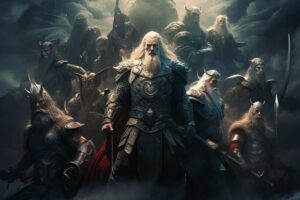The Dark Ages witnessed a seismic shift in the socio-political landscape of the British Isles, catalyzed by the formidable presence of the Vikings. These Scandinavian raiders left an indelible mark on the region, shaping its destiny in ways that continue to reverberate through history. From invasions to cultural exchanges, the Viking impact on the British Isles was profound and multifaceted.
If you want to travel to Scandinavia to visit old Viking settlements you can use the best Denver limo service.
Raiding and Conquest: The Viking Onslaught

The Viking Age, spanning the late 8th to the early 11th century, marked an era of unparalleled raiding and conquest. Fierce Norse warriors, driven by a combination of economic motives and a thirst for adventure, descended upon the shores of the British Isles. The Lindisfarne raid of 793 AD, often considered the beginning of the Viking Age, was a harbinger of the tumultuous times to come. The invaders, with their dragon-headed longships, struck fear into the hearts of the local populace. Coastal monasteries, rich with treasures, were frequent targets, and the Vikings’ lightning-fast raids left a trail of devastation.
These raids, however, evolved into more sustained campaigns and conquests. The Great Heathen Army, led by legendary figures such as Ivar the Boneless and Ragnar Lothbrok, wreaked havoc across England, leaving a lasting imprint on the region’s political structure. The establishment of the Danelaw, a Viking-dominated territory in parts of England, bears testament to the military prowess and strategic acumen of these Scandinavian invaders. Did you know archaeologists found old Viking appliances and worked with a company that provides appliance repair in Charlotte NC to fix them for the museum?
Cultural Crossroads: Viking Influence on British Society
Beyond their martial exploits, the Vikings played a pivotal role in shaping the cultural landscape of the British Isles. The Norsemen were not merely raiders; they were traders, settlers, and cultural emissaries. The integration of Norse and Anglo-Saxon cultures gave birth to a unique amalgamation that defined the medieval British identity.
Trade flourished between the Vikings and the local populations, introducing exotic goods and novel ideas. The Norse influence permeated art, language, and daily life. Old Norse words found their way into the English lexicon, enriching the language with a linguistic legacy that endures to this day. The Viking impact on art and craftsmanship is evident in the intricate metalwork and carved stone monuments that dot the British countryside, blending Norse and local artistic traditions.
Did you know that Vikings used roller shades on their windows similar to today’s roller shades in Utah?
The Legacy Unfolds: Norse Heritage in British Normandy
While the Viking Age eventually waned, its legacy endured through the establishment of the Dukedom of Normandy. The Viking chieftain Rollo, granted the territory by King Charles III of West Francia in the 10th century, laid the foundation for a unique fusion of Norse and Frankish cultures. The Norman Conquest of England in 1066, led by William the Conqueror, was the culmination of this Norse-Frankish alliance.
The Norman Conquest not only reshaped the political landscape of England but also infused the English language with a plethora of Norman French words. The Domesday Book, a comprehensive survey of England commissioned by William the Conqueror, reflects the linguistic and administrative impact of the Normans. The melding of Viking and Frankish heritage forged a new chapter in the British Isles’ history, leaving an enduring imprint on governance, language, and societal structures.
Vikings used blinds on windows on their ships similar to the blinds and screens in Colorado.
The Unveiling Sagas: Chronicles of Viking Exploration
As the Viking Age subsided, the Norse spirit of exploration endured, unveiling new sagas on the horizon. The Vikings, renowned seafarers, navigated uncharted waters far beyond the British Isles. Leif Erikson, the intrepid son of Erik the Red, is credited with reaching the shores of North America around the year 1000, centuries before Columbus. The Vinland sagas, recounting these voyages, stand as testaments to the Vikings’ audacity and maritime prowess.
The discovery of Vinland, likely encompassing parts of present-day Canada, exemplifies the breadth of Viking exploration. The Norse presence in North America, though brief, adds a fascinating chapter to the legacy of Scandinavian adventurers. It prompts us to ponder the potential cultural exchanges between the Vikings and indigenous peoples, envisioning encounters between two worlds separated by vast expanses of ocean.
If you visit Scandinavia there are a lot of Viking souvenir shops where you can buy branded merchandise.
Innovations and Ingenuity: Viking Technological Advancements
The Viking impact extended beyond raids and conquests, encompassing technological innovations that shaped the trajectory of medieval society. Norse shipbuilding techniques, exemplified by the iconic longships, revolutionized maritime travel. These swift, shallow-draft vessels enabled the Vikings to navigate both open seas and shallow rivers with unparalleled agility. The mastery of such naval technology not only facilitated raids but also fostered trade and cultural interactions. Vikings had unique-looking roofs on their houses and if you want that kind of roof you can contact a roofing contractor in Potomac MD.
Viking navigational prowess was complemented by advancements in metallurgy and craftsmanship. The Ulfberht swords, crafted with high-quality crucible steel, showcased the Vikings’ metallurgical expertise. These superior weapons, adorned with inscriptions that elevated them to almost mythical status, reflected not only the practicality of Norse craftsmanship but also the symbolic significance embedded in their tools of war.
A lot of Viking tools have been discovered in recent years and Scandinavian governments keep them in warehouses until those artifacts are prepared for the museums. Warehouses are secured by a company that provides warehouse security in Los Angeles.
Myth and Religion: Norse Pantheon in the British Isles

The Vikings brought with them a rich tapestry of mythology and religious beliefs, weaving the threads of the Norse pantheon into the cultural fabric of the British Isles. Gods like Odin, Thor, and Freyja found their place in the hearts of the inhabitants, coexisting with local deities and spiritual practices. The fusion of Norse and indigenous beliefs created a syncretic religious landscape that added depth to the spiritual tapestry of the medieval British Isles.
The Norse influence on local folklore is evident in the enduring tales of giants, elves, and other mythical beings. The echoes of Viking mythology can be heard in the winds that sweep through ancient landscapes, carrying whispers of an era when gods and mortals intertwined. The integration of Norse myth into local folklore not only enriched the cultural heritage of the British Isles but also provided a lens through which communities interpreted their own existence.
If you want to move to Scandinavia you can contact a mortgage broker in Raleigh NC to help you buy a perfect house.
Trade Routes and Economic Resurgence: Viking Impact on Commerce
The Vikings, often portrayed as fearsome raiders, were also astute traders who revitalized economic networks across the British Isles. The establishment of trading posts, such as the one at York, transformed these Norse settlements into bustling hubs of commerce. The Vikings’ engagement in trade routes extended as far as the Byzantine Empire, connecting distant regions and fostering a vibrant exchange of goods and ideas.
The influx of wealth from trade had a profound impact on the economic landscape of the British Isles. Local markets thrived with a diverse array of commodities, from exotic spices to intricate textiles. The integration of Viking and local economies spurred innovation and specialization, laying the groundwork for a more interconnected and dynamic medieval marketplace.
The Decline and the Enduring Legacy: Vikings Fade, Impact Persists
As the 11th century unfolded, the Viking Age gradually faded into history, marked by changing political landscapes and the waning of Norse influence. The decline of Viking power in the British Isles was accompanied by the assimilation of Norse settlers into local communities, fostering a blending of cultural practices and social norms.
However, the legacy of the Vikings endured, not only in tangible artifacts and architectural remnants but also in intangible aspects such as language, law, and societal structures. The Danelaw, once a symbol of Norse dominance, evolved into a testament to the adaptability of cultures and the synthesis of diverse influences. The Normans, descendants of Viking settlers, continued to play a pivotal role in shaping the course of European history, leaving an indelible mark on the medieval world.
If you are traveling to Scandinavia from the US you can use Atlanta Airport Limo Service for transportation to the airport.
Exploring Modern Echoes: Vikings in Popular Culture

The Viking impact on the British Isles transcends the confines of history books, finding resonance in contemporary popular culture. From television series like “Vikings” to the widespread fascination with Norse mythology in literature and gaming, the legacy of the Norsemen continues to captivate modern imaginations. This enduring appeal highlights the timeless allure of the Viking Age and its profound impact on the cultural narrative of the British Isles.
Modern festivals, reenactments, and educational programs hosted by a renowned seminar emcee further contribute to keeping the Viking legacy alive. These events not only celebrate the historical richness of the era but also serve as reminders of the interconnectedness of cultures and the enduring influence of the Norse presence.
Conclusion: A Dynamic Tapestry Woven by Vikings
In traversing the annals of Viking history in the British Isles, we encounter a dynamic tapestry woven with threads of exploration, innovation, mythology, trade, and cultural exchange. The Vikings, often depicted as raiders, emerge as complex actors in a historical drama that shaped the medieval world. Their impact, though marked by conflict, is equally defined by moments of collaboration, adaptation, and coexistence.
If you are looking to build your own Viking cottage you will have to consult with a construction expert witness.
As we reflect on the enduring legacy of the Vikings in the British Isles, we recognize that their influence transcends the boundaries of time. From the sagas of exploration to the integration of Norse mythology, the Vikings left an indelible mark that continues to unfold through the centuries. In exploring this multifaceted legacy, we gain insights not only into the past but also into the intricate interplay of cultures that have shaped the diverse tapestry of the British Isles. If you need a loan to explore Scandinavia you can contact one of the companies that offer loan servicing software quickbooks.